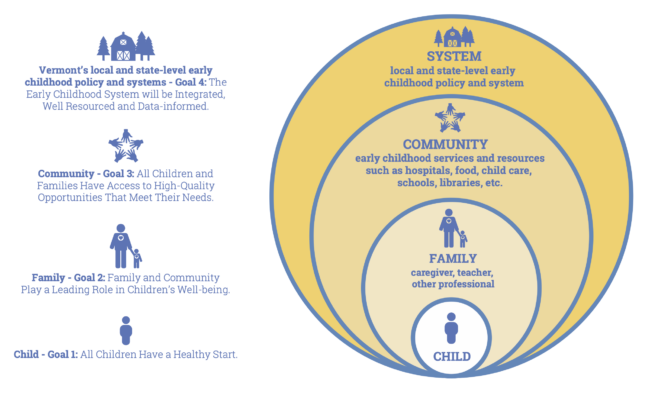
On Monday, May 20, the State Advisory Council and more than 100 community partners gathered virtually (watch the video recording) to celebrate progress towards the state’s vision and strategic plan for the early childhood system and identify priorities and opportunities for the next year. Vermont’s Early Childhood Action Plan, or VECAP, is designed to build collective accountability to achieve measurable goals by 2026.
The VECAP articulates the following vision for Vermont’s children and families: Vermont aspires to realize the promise of each and every Vermont child by ensuring that the early childhood system is an integrated, continuous, comprehensive, high-quality system of services that is equitable, accessible, and will improve outcomes for children in the prenatal period to age 8 and their families.
The annual VECAP Summit is one way we document and celebrate progress toward the vision outlined in the VECAP. Having a diverse range of partners represented at the Summit is key in collecting well-rounded qualitative data on our progress towards reaching the VECAP’s four goals.
Information shared at the summit suggests we are making progress toward meeting the four goals outlined in the VECAP:
Goal 1: All Children Have a Healthy Start
Goal 2: Families and Communities Play a Leading Role in Children’s Well-Being
Goal 3: All Children and Families Have Access to High-Quality Opportunities That Meet Their Needs
Goal 4: The Early Childhood System Will be Integrated, Well-Resourced, and Data-Informed
Where are we making progress and positively impacting young children and families? Much progress has been made since the plan was updated in 2020, especially in policy changes and collaboration.
Policy changes
- In 2024, Vermont expanded health insurance coverage to immigrant families and extended Medicaid coverage for birthing parents through 12 months postpartum.
- Thanks to Act 76, Vermont has made significant new investments in the Child Care Financial Assistance Program.
- One participant at the summit shared, “Children whose families could not afford full-time enrollment are now able to access care five days a week to help prepare them for kindergarten.”
- Families are glad to finally have lower copays, without negatively impacting the program that serves their children.
- Partners also reported that due to these investments, programs have been able to increase wages and benefits as well as to offer more professional development opportunities.
- TEACH, VT ECE Youth Apprenticeship model, and ARPA investments have increased credentialing opportunities for early childhood educators.
Collaboration and relationship-building
Partners reported areas where collaboration and partnerships are growing. Medical clinics have added care coordinators, communities are partnering on mobile mental health response teams, and school districts are hosting events to support transitions and readiness for kindergarten. We continue to see a gap in autism diagnosis access, and in response, VCHIP launched a training for pediatricians to evaluate children, with 16 newly trained physicians and more on the waitlist. Check out BBF’s latest blog on expanded autism screening in Franklin County.
What parts of the early childhood system demonstrate continued need?
While the VECAP Summit highlighted some progress happening at the programmatic, policymaking, and regional levels, more is needed across VECAP goals to improve the early childhood system for children, families, and the early childhood workforce.
Kindergarten transitions and readiness are improving across the state, but more statewide data sharing and guidance for school districts and early childhood education programs on best practices are needed.
While some employers offer family-friendly policies, and the state recently rolled out a voluntary paid family and medical leave program, access to these programs is not equitable and varies widely across sectors and business sizes.
Frameworks are in place for statewide workforce investments, but Vermont still lacks the people to fill these roles. Staffing shortages extend across CIS providers, early childhood special educators, early educators, mental health, and nearly all direct service organizations, but there has not been the same level of resources invested across services provided for children.
And while data collection efforts are improving, limitations on outdated state-level data systems such as those used by DCF Family Services, CIS, and the Agency of Education prevent Vermont from achieving data’s full potential to inform policy. Reporting on inequities based on race and ethnicity is frequently a challenge due to data suppression standards (to protect the privacy of children and families).
Where do we go from here?
There are many ways to engage with the BBF Network and to make progress toward our collective vision for Vermont’s early childhood system. Last month, we rededicated ourselves to the vision and priorities set forth in the VECAP and identified gaps as we prepare to update the VECAP for 2026–2030 starting this summer! Stay tuned for details and how to get involved.


